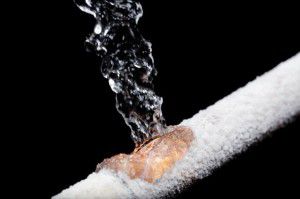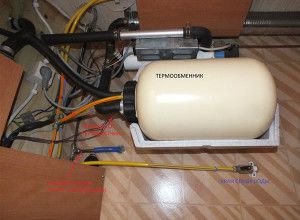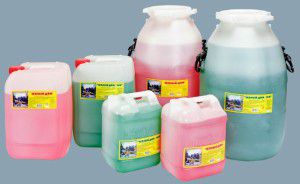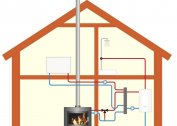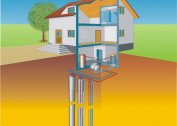During operation of the heating system, the coolant may freeze. This leads to emergency situations. They can only be avoided by replacing the water in the pipelines with a special composition, the freezing temperature of which is much lower than 0 ° С. Is it possible to make such a non-freezing fluid for home heating systems with your own hands?
We do antifreeze on our own
It should be noted immediately that ordinary water is the best type of coolant. It has sufficient heat capacity, has an optimal density, affordable cost. Therefore, if the probability of exposure to negative temperatures on heat supply is minimal, it is best to use distilled water.
But if it is impossible to comply with this condition, a special non-freezing liquid for heating boilers will be required. It is a solution in which water occupies up to 70% of the total volume. The rest are additives that lower the crystallization threshold to -60 ° C. They include:
- Main component - ethylene glycol, propylene glycol or glycerin. This non-freezing fluid for the home heating system has a high viscosity coefficient, which leads to the desired effect;
- Additives. Thanks to them, the non-freezing liquid for water heating does not foam, and does not form a crystalline precipitate when the temperature rises.
The problem of self-production of such a composition is the correct selection of the last component. All manufacturers do not disclose the complete list of components. But even knowing how to make the correct composition, it is impossible to do it at home - this will require special equipment and compliance with manufacturing technology.
How to make a non-freezing liquid for heating yourself, and what are the consequences of its use?
- An increase in the level of foam during heating of the coolant will entail the rapid formation of sediment on the walls of pipes and radiators;
- Decrease in heat transfer of improvised non-freezing fluid. This will cause a significant decrease in heating efficiency;
- The self-made non-freezing liquid for heating can negatively affect the steel elements of the system due to the high oxygen content. Corrosion processes will accelerate.
Any non-freezing fluid for stove heating or a solid fuel boiler should not cause these undesirable effects. Therefore, to maintain the safety of the system, it is recommended to use only high-quality non-freezing liquid for water heating from a reliable manufacturer.
Before using antifreeze, you should familiarize yourself not only with its composition and recommendations for use, but also carefully study the instructions of the heating boiler. It should indicate the types of coolant that can be filled.
Types of non-freezing fluid for heating
Having determined that the non-freezing coolants for the heating system should be only of factory quality, you can start choosing a specific composition. It must be adapted to a specific heat supply scheme, and its operational performance cannot degrade system parameters.
Before pouring non-freezing liquid into the heating system, you need to find out whether it will adversely affect the components of the heat supply. To do this, read the instructions for use, which must be attached. It is also important to pay attention to the main component of non-freezing liquid for heating boilers. Not only the condition of the heat supply components depends on this, but also the operating conditions:
- Ethylene glycol. It is characterized by high toxicity. Therefore, it can be applied only in closed circuits. It can be difficult to fill this type of freezing fluid into the heating system. In the vapor state it is dangerous for human health;
- Propylene glycol. In fact, it is a food additive, therefore, it is allowed to use both in open and closed heating systems. Unlike ethylene glycol, the crystallization temperature is + 80 ° С, which makes it possible to use it for operation of solid fuel high-temperature boilers. The only drawback is the high cost;
- Glycerol. The most popular type of non-freezing fluid for stove heating. Its performance is slightly lower than that of propylene glycol. However, along with this, the cost of glycerol antifreeze is an order of magnitude less. The disadvantages include greater fluidity. This may affect the tightness of pipelines. The way out is to replace rubber gaskets with paronite ones.
Currently, the use of non-freezing fluid for a glycerin-based home heating system is the best option.
| Name | Structure | Price, rub / l |
| Warm house -30 ° С | Propylene glycol | 65 |
| Dixis -65 | Glycerol | 75 |
| Comfort Technology -65 | Ethylene glycol | 120 |
Manufacturers offer 2 types of non-freezing coolants for the heating system - in a ready-to-use state and concentrate. For large heat supply schemes, it is more profitable to purchase a concentrate. However, this complicates the process of filling the system.
When purchasing a ready-to-use liquid, you need to pay attention to the lower critical level of freezing temperature. It can be from -25 ° C to -65 ° C.
Features of pouring antifreeze into the heating system
In order not to make the most anti-freezing liquid for heating and at the same time risk the performance of the entire system - you need to purchase a ready-made composition. However, in addition to this, you should familiarize yourself with the filling technology.
If the system has an old coolant, it should be drained. It is recommended to check its condition. The degree of contamination indicates the relevance of a comprehensive cleaning. It is performed before pouring antifreeze into the heating system. Subsequent stages of work consist in the implementation of the following items:
- If antifreeze was used before - A complete flushing of the system is mandatory. Otherwise, mixing two different non-freezing fluids for furnace heating can lead to undesirable chemical reactions;
- Closed system. In it, the pouring point should be below all other heating devices. With the help of pumping equipment, the heating system of a private house is filled with non-freezing liquid. It is important that the pressure in the pipes does not exceed a value of 3 atm;
- Open system. For her, the use of non-freezing liquid for water heating is not recommended. Continuous contact with air can lead to a significant increase in foaming. Filling is carried out through the upper expansion tank;
- Heating test. The temperature in the system rises gradually. At the same time, the tightness of all nodes is checked, as well as the absence of extraneous noise during the circulation of the coolant.
During operation, you will need to add non-freezing liquid for heating yourself. Therefore, it is recommended to purchase it with a margin - 15-20% more of the calculated system volume.
You can’t make a non-freezing liquid for heat supply yourself. It is also not recommended to use automotive antifreezes, as they are in most cases made on the basis of unsafe propylene glycol.
Restrictions on the use of antifreeze in heat supply
Despite all its positive aspects, not every non-freezing liquid is suitable for heating boilers. Improper use can lead to the gradual destruction of the heat exchanger and the rapid failure of expensive equipment.
In addition to this, there are a number of other restrictions that must be taken into account when using an anti-freezing coolant for heating systems:
- Many models of double-circuit boilers are not designed for antifreeze. It can get into the DHW system, which is an undesirable factor;
- Non-freezing fluid negatively affects the galvanized surface. There is a rapid destruction of the protective layer and, as a result, the failure of the heating element;
- Since the viscosity of antifreeze is much higher than that of water, heating must be understaffed with powerful circulation pumps. The lower the critical level of freezing temperature - the greater the productivity of the pumps;
- Antifreeze replacement should be carried out clearly on the recommendation of the manufacturer. Over time, it loses its properties, which directly affects the performance of the heating system.
Non-freezing fluid concentrate is diluted only with distilled water. An ordinary flow-through is unsuitable for this - a large number of third-party elements can cause an undesirable chemical reaction.
The video material details the options for choosing antifreeze for heating systems:
